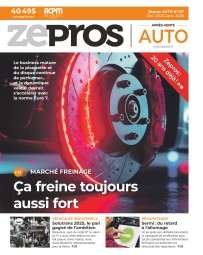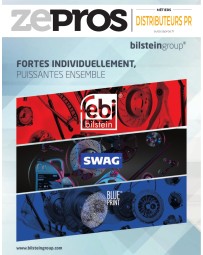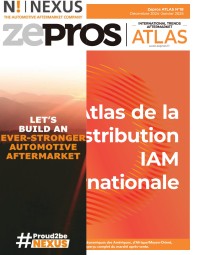
"Magneti Marelli has changed its mindset”

The Italian Magneti Marelli, under the ownership of Japanese company Calsonic Kansei (a KKR fund entity) since its sale by Fiat in 2018, has faced challenges similar to those of its car manufacturing clients. Yet, it has firmly established itself in a vibrant aftermarket. Andrea Anfossi, Head of Parts and Services for Southern Europe, outlines the global giant’s after-sales roadmap.
How has Magneti Marelli Parts & Services evolved over the past two years?
Andrea Anfossi: We’ve witnessed great prospects driven by global demand for spare parts. The reasons are clear: vehicle parcs are growing, aging, and consuming more spare parts. This trend is evident through our distribution network spanning over 100 countries—Europe, Asia, North and South America, Africa, and Oceania—as well as through our Checkstar Service Network and Checkstar Car Body Network in countries like Italy, Spain, Germany, Poland, Brazil, Argentina, and China. Our portfolio is designed to meet workshop needs, including body parts, alternators, starters, electrical and electronic products, technical parts, consumables, and garage tools.
Where are your growth levers?
AA: We operate across three zones: South America, EMEA, and APAC. Over the last three years, we’ve seen a global boom due to aging vehicle parcs. In Europe, for example, Italy remains a key market, with strong demand for technical parts like brakes, shock absorbers, and filters. In France and Germany, sales of electronic parts and lighting systems have been increasing significantly.
Has inflation impacted your operations?
AA: Over the past two years, high inflation rates in Europe and elsewhere have led to price surges across the sector. We’ve carefully managed inflationary pressures and product price increases. Volumes have increased and we have achieved a balance between price increases and costs like transport expenses. Additionally, the rising complexity of parts, particularly lighting and electronics, has contributed to price growth. Moving forward, we anticipate less volume but higher prices due to increasing technological sophistication. We must be ready to move in this direction.
“Continually adapt, even if it means upending existing models.”
In this sector, who is the most competitive?
AA: Among equipment manufacturers, I’ve noticed a steady improvement in the quality of parts and components from China. While we must remain vigilant, China is not the insurmountable threat it is sometimes perceived to be. It is not a monster. On the distribution front, Europe has seen consolidation while maintaining country-specific nuances. There is not a revolution but there are developments. For example, in Italy, the emergence of large distribution platforms like Autodis and Distrigo has transformed the landscape while adapting to the territory’s complexities. Similar developments are evident in Spain and France.
Could a Chinese distributor establish operations in Europe?
AA: It’s entirely possible. Chinese players are not just strong in manufacturing but also in distribution. Their rapid rise in digital sectors, such as Alibaba, demonstrates this. Although Alibaba hasn’t achieved Amazon’s stature, their success shows the potential of Chinese distributors entering European markets.
Do you see alliances between OES and IAM as viable?
AA: There was once a belief that the OEM aftermarket would naturally surpass independent markets, but the opposite has occurred. OES market shares have hit a ceiling across Europe. Magneti Marelli, having been part of Fiat Chrysler until 2018, understands this dynamic well. Due to differing structures and objectives, OES has not matched the agility of independent spare parts players. It Is not just a question of margins. Manufacturers like Stellantis have started to bridge the gap by hiring aftermarket specialists to better understand the space. However, the complexity of managing multiple brands within a group—like Stellantis’ fourteen brands—remains a challenge.
What are Magneti Marelli’s major challenges?
AA: Our main challenge is to continually adapt, even if it means upending existing models. This involves offering the services needed across the supply chain—from distribution to repair. For instance, we’ve adapted by phasing out obsolete product lines, like carburetors, and aligning our portfolio with the needs of current vehicle parcs. Logistics is another critical area, as is supporting workshops with equipment, training, and more.
Digitalisation is a significant challenge we’re addressing through our “5.0 Digital Wave” project. This initiative focuses on digitalising stakeholder interactions—customer relationship management, supply chain, pricing, and claims management. By combining technology with process simplification, this project is reshaping Magneti Marelli Parts & Services to deliver value throughout the supply chain.
A third challenge is addressing the labour shortage in workshops. Recruitment and training are vital for the sector’s growth. We are investing in technical institutes and specialised schools, but motivating and attracting the next generation remains a major hurdle.
What is your vision for the next five years?
AA: I believe the industry will continue to thrive, with vehicles becoming even more prevalent globally. I repeat that success will depend on our ability to develop products that meet market needs, offering differentiated ranges in terms of quality, price, and service. Affordability is key, as today’s customers—both workshops and their customers—have evolved. Magneti Marelli has changed its mindset to align with these new expectations.







